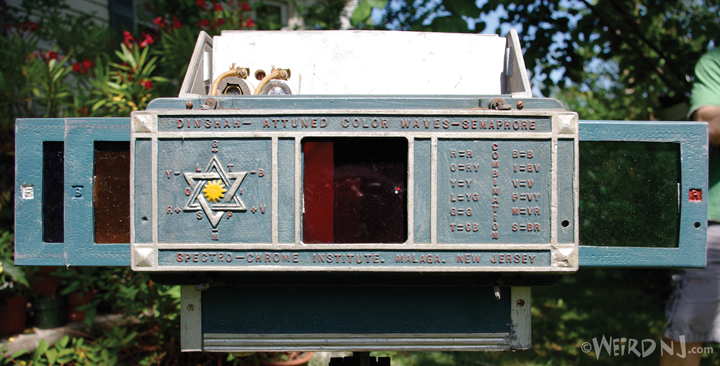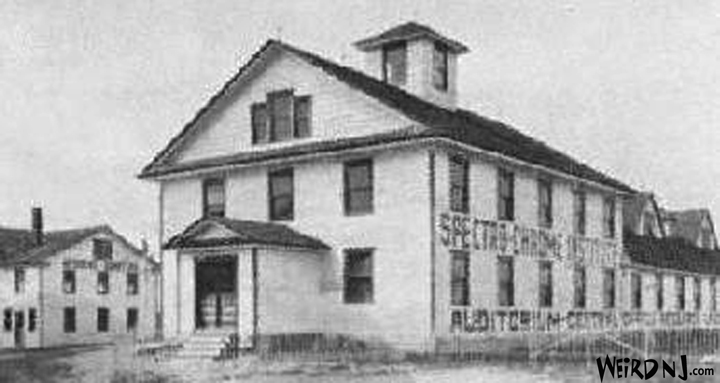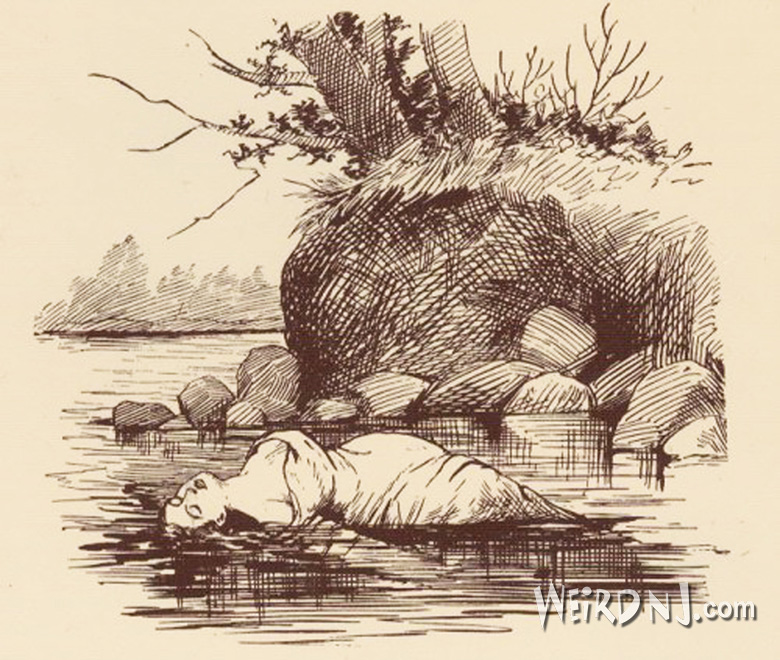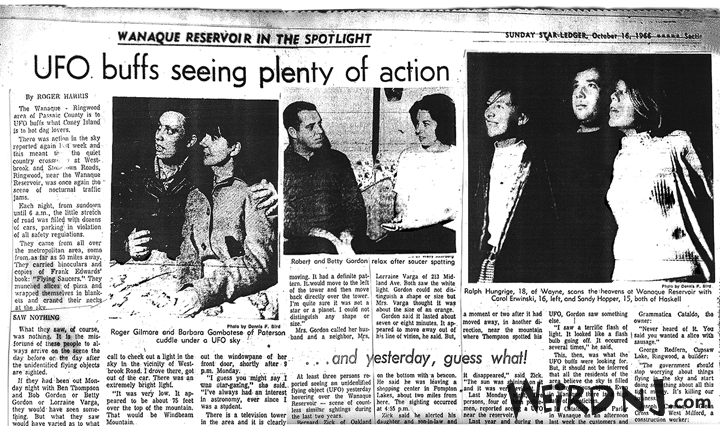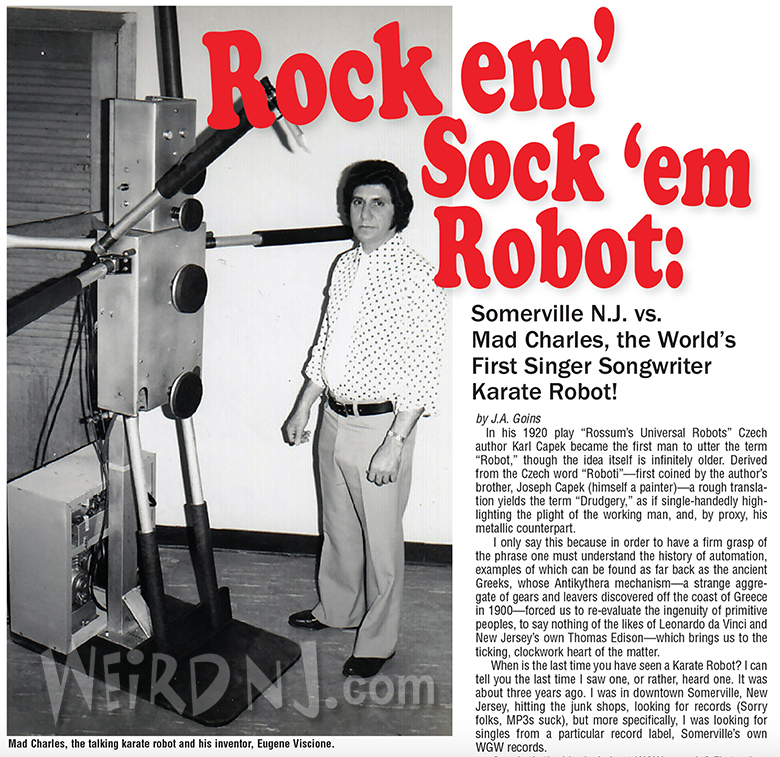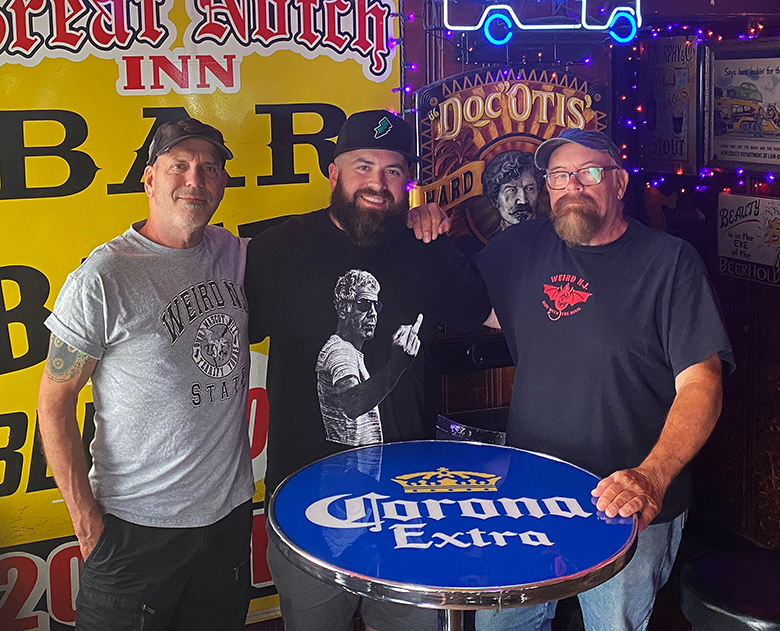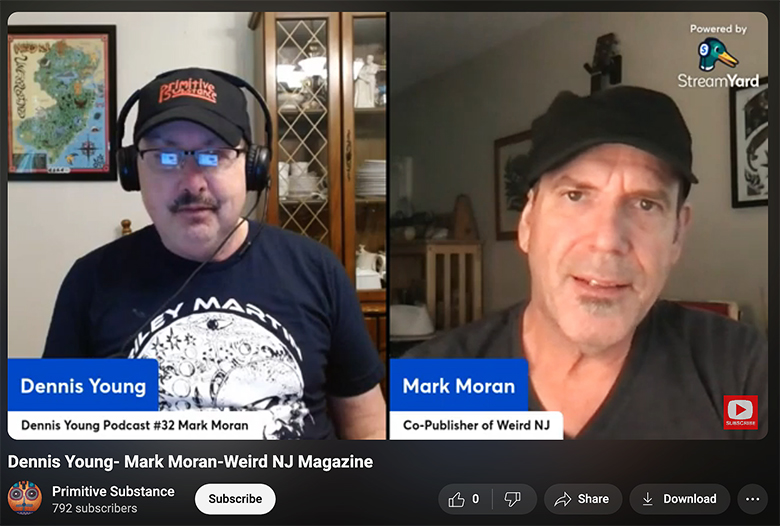Spectro-Chrome Therapy – Technicolor Cures or Kaleidoscopic Quackery?
In the 1930s the Vineland area of Cumberland County, NJ must have been a very unusual place indeed. Perhaps there was something in the water, or maybe the Great Depression left local residents with so much free time on their hands that they just didn’t know what to do with themselves so they resorting to delving deeply into their own strange and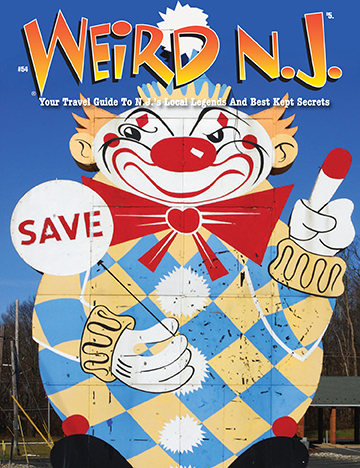 obsessive preoccupations. We can’t really say for sure which might be the case, but during that time period a number of unique and enigmatic people were working in weird ways on their own unique projects.
obsessive preoccupations. We can’t really say for sure which might be the case, but during that time period a number of unique and enigmatic people were working in weird ways on their own unique projects.
One was a mysterious drifter named George Daynor who settled into a swampy patch of property on South Mill Road and began building his Palace Depression. Constructed entirely by hand from stones, concrete and odd junk, the fairytale castle would become a well known bizarre landmark. At the same time, not far across town on South Main Street, an unemployed plumber and electrician named George Arbuckel was hard at work personalizing his own eccentric property, which he called Gempokus Farms, adorning it with majestic statuary and even an enormous backyard replica of the Statue of Liberty.
Subscribe to Weird NJ magazine for 2020!
That’s right, Weird NJ issues #54 and #55 can be delivered right to your door in May and October of 2020. (Current and recent issues can be purchased HERE.)
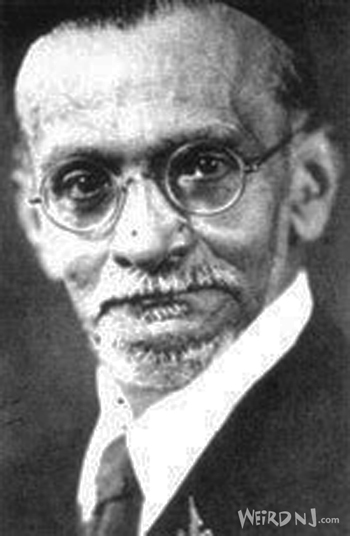 There was also a “doctor” practicing his own dubious version of medical science during the very same time period not far away, just over the Vineland border in the town of Malaga (Franklin Township). Dinshah P. Ghadiali was his name, and he promised that his invention, the Spectro-Chrome device could miraculously cure just about all forms of human ailments without the aid of any drugs or surgery. All that was required for perfect health, according to the good doctor, was his magical machine––which was really nothing more than an aluminum box containing a 1,000 watt bulb and a number of small multi-colored windows to shine the light through onto the affected area of the patient’s body. To cure yourself you simply had to arrange the correct combinations of colored lens and voilà!––your malady would disappear.
There was also a “doctor” practicing his own dubious version of medical science during the very same time period not far away, just over the Vineland border in the town of Malaga (Franklin Township). Dinshah P. Ghadiali was his name, and he promised that his invention, the Spectro-Chrome device could miraculously cure just about all forms of human ailments without the aid of any drugs or surgery. All that was required for perfect health, according to the good doctor, was his magical machine––which was really nothing more than an aluminum box containing a 1,000 watt bulb and a number of small multi-colored windows to shine the light through onto the affected area of the patient’s body. To cure yourself you simply had to arrange the correct combinations of colored lens and voilà!––your malady would disappear.
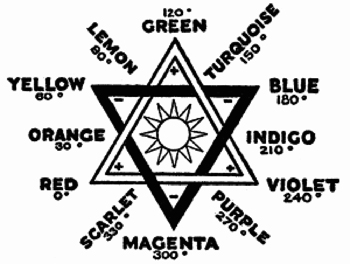 Part of Ghadiali’s instructional literature that came with the device was a chart describing the “Spectro-Chrome Therapeutic System.” It explained that green light is a pituitary stimulant, a germicide and a muscle tissue builder; yellow light is a digestant, an anthelmintic and a nerve builder; red is a liver energizer, a caustic and a haemoglobin builder; violet is a cardiac depressant; blue a vitality builder; indigo a hemostatic; turquoise, a tonic; lemon, a bone builder; orange, an emetic; scarlet, a genital excitant; magenta, a suprarenal stimulant, and purple an anti-malarial.
Part of Ghadiali’s instructional literature that came with the device was a chart describing the “Spectro-Chrome Therapeutic System.” It explained that green light is a pituitary stimulant, a germicide and a muscle tissue builder; yellow light is a digestant, an anthelmintic and a nerve builder; red is a liver energizer, a caustic and a haemoglobin builder; violet is a cardiac depressant; blue a vitality builder; indigo a hemostatic; turquoise, a tonic; lemon, a bone builder; orange, an emetic; scarlet, a genital excitant; magenta, a suprarenal stimulant, and purple an anti-malarial.
In case all of this multi-colored mumbo jumbo seems a little bit too bedazzling for you, dear reader, Weird NJ has engaged the services of an actual doctor to enlightened us all…
Colorful Nonsense: Dinshah Ghadiali and His Spectro-Chrome Device
Dr. Joseph A. Schwarcz, Ph.D.
Dinshah P. Ghadiali (1873-1966), inventor of the Spectro-Chrome, was born in Bombay, India. At least by his own account, he was a remarkable man. He began school at the ripe old age of two and a half; by eight he was in high school, and by eleven he was an assistant to a professor of mathematics at a Bombay college. Dinshah, as he liked to be called, claimed that he began to study medicine at the age of 14. His writings say nothing further about attending medical school––probably because he saw no need to continue after he concluded that color therapy was the key to health. His publications identified his credentials as “(Honorary) M.D., M.E., D.C., Ph.D., LL.D., N.D., D.Opt., F.F.S., D.H.T., D.M.T., D.S.T., Etc.”
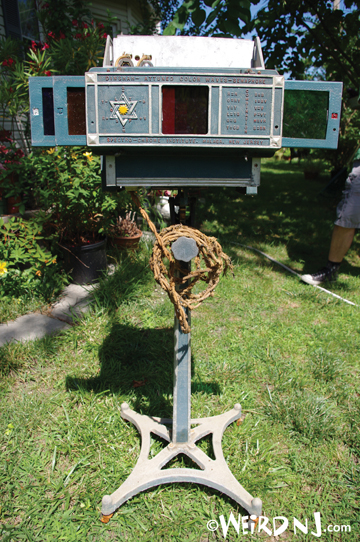 Dinshah allegedly became enamored with color healing after curing a young girl dying of colitis by exposing her to light from a kerosene lamp fitted with an indigo-colored filter. The therapy also involved giving the patient milk that had been placed in a bottle of the same color and exposed to sunlight. Within three days, the girl was well and Dinshah’s career had been launched. He opened Electro-Medical Hall in Surat, India, and began to refine his techniques.
Dinshah allegedly became enamored with color healing after curing a young girl dying of colitis by exposing her to light from a kerosene lamp fitted with an indigo-colored filter. The therapy also involved giving the patient milk that had been placed in a bottle of the same color and exposed to sunlight. Within three days, the girl was well and Dinshah’s career had been launched. He opened Electro-Medical Hall in Surat, India, and began to refine his techniques.
By the time Dinshah emigrated to America in 1911, he had a theory––albeit a bizarre one––to go with his colored lights. Every element, he said, exhibits a preponderance of one of the seven prismatic colors. Oxygen, hydrogen, nitrogen, and carbon, the elements that make up 97% of the body, are associated with blue, red, green, and yellow. In a healthy person these colors are balanced, but they fall out of balance when disease strikes. The therapy is simple: to cure a disease, administer the colors that are lacking or reduce the colors that have become too brilliant.
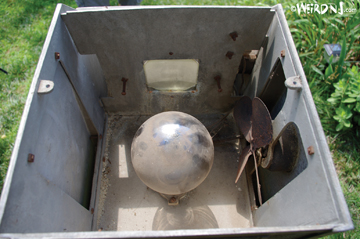
The Spectro-Chrome was a box with a 1000-watt light bulb in it and an opening fitted with colored filters “Attuned Color Wave Slides”. The five filters could be deployed singly or in pairs to produce twelve different colors. The device was sold together with the Spectro-Chrome Therapeutic System guide, which detailed which colors to shine on a given patient. Green light, for example, was a pituitary stimulant and germicide, while scarlet was a genital stimulant. Any disease or condition, Dinshah insisted, except for broken bones, was amenable to color therapy. He also maintained that the Spectro-Chrome was especially suited for use by intelligent people, because “drugs quickly upset the nervo-vital balance of persons of high mental and spiritual development.” A pretty clever ploy––the gullible, thinking themselves to be intelligent, ate it up.
His slogan, “No Diagnosis, No Drugs . . . No Surgery,” also sat well with a public largely unsatisfied with available medical care. The idea of a noninvasive therapy and the promise of a cure for virtually any ailment were very appealing. He also advocated strict avoidance of all “flesh,” fowl, fish, eggs, honey, tea, coffee, tobacco, intoxicants, and lard, a regimen that was healthier than the diet and lifestyle of many Americans. Continue reading below…
Back From The Dead! Out-of Print Issues of Weird NJ Now Available for Your Favorite E-Reading Device!
Our digitally formatted publications contains the exact same pages that were once featured in our print magazines. They have not been modified in any way for these ePubs. Get them all for your iPad or Kindle device.
Dinshah’s publications reflected great antagonism toward the medical profession. He called vaccination a “curse” and depicted “The Medical Octopus”––with tentacles that included the AMA, the American College of Surgeons, the Better Business Bureau, the Good Housekeeping Institute––with the “Bay of Bunk” on one side and the “Ocean of Ignorance” on the other side.
Of course, it wasn’t long before Dinshah ran into trouble with the establishment. He was labeled a fraud and a charlatan by the American Medical Association but managed to portray himself cunningly as a humanitarian who was being persecuted by money-grubbing, ineffectual, jealous physicians. To protect himself legally, Dinshah invented his own jargon. He didn’t talk of “cures,” he spoke of “normalating” the body. Instead of “treating” patients, he would “restore their Radio-Active and Radio-Emanative Equilibrium.”
In 1925, Dinshah was prosecuted for transporting a 19-year-old girl––his secretary––across state lines for immoral purposes. (Perhaps he had been overexposing himself to scarlet light.) He spent four years in jail. In 1931, he was arraigned on second-degree grand larceny charges after a former student complained to officials that the Spectro-Chrome did not perform as promised. In defending himself, Dinshah trotted out numerous satisfied patients, including––incredibly––several physicians. In fact, a surgeon, Kate Baldwin, claimed that she bad successfully treated glaucoma, tuberculosis, cancer, syphilis, and a very serious burn case with Dinshah’s device. The government had experts testifying that the Spectro-Chrome was merely an ordinary lamp and that any successes were due to the placebo effect or the natural course of the ailment. Ultimately, the prosecution could not prove the intent to defraud, and Dinshah was found not guilty. He went back to selling more Spectro-Chrome devices with claims that he had been vindicated “without a lawyer. . . in open court . . . against an array of University Professors” and that “Spectro Chromemetry is established for all time.”
Subscribe to Weird NJ magazine for 2020!
That’s right, Weird NJ issues #54 and #55 can be delivered right to your door in May and October of 2020. (Current and recent issues can be purchased HERE.)
After the passage of the Food, Drug, and Cosmetic Act of 1938, which gave the FDA some teeth in regulating therapeutic devices, the government again began to assemble evidence against Dinshah. Finally, in 1945, he was charged with introducing a misbranded article into interstate commerce, a violation of the criminal code. Once again, he trotted out his satisfied patients, but this time there were no supporting physicians. His fate was virtually sealed when a star witness, whom Dinshah had “cured” of seizures, had one on the witness stand.
Dinshah was heavily fined, his books and lamps were seized, and he was put on five-year probation. The day after his probation ended, he was at it again. This time, he founded the Visible Spectrum Research Institute and sold lamps labeled as having “no curative or therapeutic value.” He strenuously implied in his literature that this was only a means of keeping the FDA dogs away––just meaningless legalese that David had to resort to in his eternal battle with Goliath. In 1958, the government obtained a permanent injunction against shipping Spectro-Chromes across state lines, but the persistent Dinshah kept selling the things in New Jersey.
After his death in 1966, his sons took over and managed to have the Dinshah Health Society of Malaga, New Jersey, registered as a nonprofit, scientific, educational, tax-exempt organization. The society still sells all kinds of light-therapy books, including a history of the Spectro-Chrome by Dinshah himself in seven cloth-bound volumes priced at $220. You can also buy instructions for building an inexpensive Spectro-Chrome from a light bulb, cardboard, and colored plastic sheets. Apparently, the society does not sell the finished product, but another company on the Internet did advertise Color Light Therapy Lamps “as recommended by Dinshah.” These look suspiciously like theater spotlights with colored gels. A “chromotherapy” course, “offered with the approval and blessings of the Dinshah Health Society, has been available at non-accredited Westbrook University. And courses in “chromotherapy” and “spectro-chrome therapy” are available at the Institute for Chromotherapy in Ellicottville, New York.
Dr. Joseph A. Schwarcz, better known to his students as Dr. Joe, has a PhD in chemistry and is a professor at McGill University in Montreal, Quebec. He is the director of McGill’s Office for Science & Society, which is dedicated to demystifying science for the public. www.mcgill.ca/oss www.facebook.com/McGillOSS
As if the story Dinshah Ghadiali wasn’t already strange enough, a bizarre side note to his tale is that in 1937, after all of his troubles with law, he apparently threw his hat into the ring as a candidate for New Jersey State Governor! What’s really astonishing about all this unusual history of the Vineland and Malaga area is that after all of these years, much of it still exists today, in one form or another, not that different than it was way back in the 1930s. Remarkably, the Palace of Depression is in the process of being rebuilt in a faithful reproduction of its original weird design. George Arbuckel’s Gemapokus Park, though now owned by a different family, still occupies a place on South Main Road, its marvelous concrete statuary looking none the worse for their age and still as impressive and curious as ever––a lasting testament to the craftsmanship of their creator.
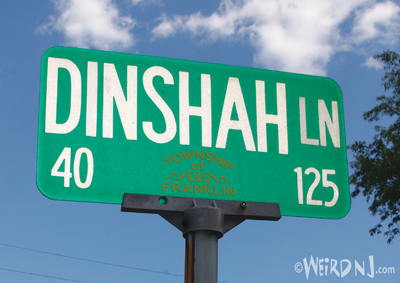 After Dinshah’s death in 1966, his son, Hom Jay Dinshah became the founder and president of the American Vegan Society and editor of its publication, Ahimsa magazine until his own death in 2000. The society is still headquartered in Malaga today on Dinshah Lane, on a family-owned parcel of land they call “Suncrest”, or “the Suncrest Educreational Center”. The center offers vegan publications, outreach, and spiritual inspiration.
After Dinshah’s death in 1966, his son, Hom Jay Dinshah became the founder and president of the American Vegan Society and editor of its publication, Ahimsa magazine until his own death in 2000. The society is still headquartered in Malaga today on Dinshah Lane, on a family-owned parcel of land they call “Suncrest”, or “the Suncrest Educreational Center”. The center offers vegan publications, outreach, and spiritual inspiration.
While the senior Dinshah’s Spector-Chrome device might sound like nothing more than a harmless bit of quackery to us today, we can’t help but wonder about all the suffering, and even death, that his believers might have been spared had they not bought into his scam and instead had the benefit of more proven medical procedures to help cure what ailed them.
The preceding article is an excerpt from Weird NJ magazine, “Your Travel Guide to New Jersey’s Local Legends and Best Kept Secrets,” which is available on newsstands throughout the state and on the web at www.WeirdNJ.com.
Photos: ©Weird NJ / Mark Moran
Now you can have all of your favorite Weird NJ icons on all kinds of cool new Weird Wear, like Tee Shirts, Girls Tees, Sweatshirts, Long Sleeve Tees, Hoodies, Unisex Tanks, Kids Tees, Tie Dyes or Onesies! All are available in all sizes and a variety of colors. Show the world your Jersey pride in some of our Jersey-centric goodies. Represent!

